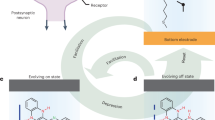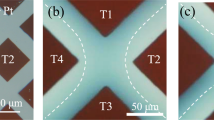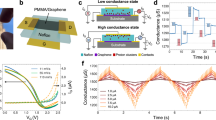Abstract
Moiré quantum materials host exotic electronic phenomena through enhanced internal Coulomb interactions in twisted two-dimensional heterostructures1,2,3,4. When combined with the exceptionally high electrostatic control in atomically thin materials5,6,7,8, moiré heterostructures have the potential to enable next-generation electronic devices with unprecedented functionality. However, despite extensive exploration, moiré electronic phenomena have thus far been limited to impractically low cryogenic temperatures9,10,11,12,13,14, thus precluding real-world applications of moiré quantum materials. Here we report the experimental realization and room-temperature operation of a low-power (20 pW) moiré synaptic transistor based on an asymmetric bilayer graphene/hexagonal boron nitride moiré heterostructure. The asymmetric moiré potential gives rise to robust electronic ratchet states, which enable hysteretic, non-volatile injection of charge carriers that control the conductance of the device. The asymmetric gating in dual-gated moiré heterostructures realizes diverse biorealistic neuromorphic functionalities, such as reconfigurable synaptic responses, spatiotemporal-based tempotrons and Bienenstock–Cooper–Munro input-specific adaptation. In this manner, the moiré synaptic transistor enables efficient compute-in-memory designs and edge hardware accelerators for artificial intelligence and machine learning.
This is a preview of subscription content, access via your institution
Access options
Access Nature and 54 other Nature Portfolio journals
Get Nature+, our best-value online-access subscription
$29.99 / 30 days
cancel any time
Subscribe to this journal
Receive 51 print issues and online access
$199.00 per year
only $3.90 per issue
Buy this article
- Purchase on Springer Link
- Instant access to full article PDF
Prices may be subject to local taxes which are calculated during checkout




Similar content being viewed by others
Data availability
Data for all figures are available at the Harvard Dataverse repository (https://doi.org/10.7910/DVN/1LZUH5).
Code availability
Code for all algorithms is available from the Harvard Dataverse repository (https://doi.org/10.7910/DVN/1LZUH5).
References
Cao, Y. et al. Unconventional superconductivity in magic-angle graphene superlattices. Nature 556, 43–50 (2018).
Cao, Y. et al. Correlated insulator behaviour at half-filling in magic-angle graphene superlattices. Nature 556, 80–84 (2018).
Zheng, Z. et al. Unconventional ferroelectricity in moiré heterostructures. Nature 588, 71–76 (2020).
Mak, K. F. & Shan, J. Semiconductor moiré materials. Nat. Nanotechnol. 17, 686–695 (2022).
Sangwan, V. K. et al. Self-aligned van der Waals heterojunction diodes and transistors. Nano Lett. 18, 1421–1427 (2018).
Sangwan, V. K. et al. Multi-terminal memtransistors from polycrystalline monolayer molybdenum disulfide. Nature 554, 500–504 (2018).
Beck, M. E. & Hersam, M. C. Emerging opportunities for electrostatic control in atomically thin devices. ACS Nano 14, 6498–6518 (2020).
Beck, M. E. et al. Spiking neurons from tunable Gaussian heterojunction transistors. Nat. Commun. 11, 1565 (2020).
Sharpe, A. L. et al. Emergent ferromagnetism near three-quarters filling in twisted bilayer graphene. Science 365, 605–608 (2019).
Serlin, M. et al. Intrinsic quantized anomalous Hall effect in a moiré heterostructure. Science 367, 900–903 (2020).
Xu, Y. et al. Correlated insulating states at fractional fillings of moiré superlattices. Nature 587, 214–218 (2020).
Gu, J. et al. Dipolar excitonic insulator in a moiré lattice. Nat. Phys. 18, 395–400 (2022).
Chen, D. et al. Excitonic insulator in a heterojunction moiré superlattice. Nat. Phys. 18, 1171–1176 (2022).
Zhang, Z. et al. Correlated interlayer exciton insulator in heterostructures of monolayer WSe2 and moiré WS2/WSe2. Nat. Phys. 18, 1214–1220 (2022).
Zidan, M. A., Strachan, J. P. & Lu, W. D. The future of electronics based on memristive systems. Nat. Electron. 1, 22–29 (2018).
Christensen, D. V. et al. 2022 roadmap on neuromorphic computing and engineering. Neuromorphic Comp. Eng. 2, 022501 (2022).
Akarvardar, K. & Wong, H.-S. P. Technology prospects for data-intensive computing. Proc. IEEE 111, 92–112 (2023).
Sangwan, V. K. & Hersam, M. C. Neuromorphic nanoelectronic materials. Nat. Nanotechnol. 15, 517–528 (2020).
Xue, F. et al. Integrated memory devices based on two-dimensional materials. Adv. Mater. 34, 2201880 (2022).
Sangwan, V. K., Liu, S. E., Trivedi, A. R. & Hersam, M. C. Two-dimensional materials for bio-realistic neuronal computing networks. Matter 5, 4133–4152 (2022).
Niu, R. et al. Giant ferroelectric polarization in a bilayer graphene heterostructure. Nat. Commun. 13, 6241 (2022).
Woods, C. et al. Charge-polarized interfacial superlattices in marginally twisted hexagonal boron nitride. Nat. Commun. 12, 347 (2021).
Yasuda, K., Wang, X., Watanabe, K., Taniguchi, T. & Jarillo-Herrero, P. Stacking-engineered ferroelectricity in bilayer boron nitride. Science 372, 1458–1462 (2021).
Vizner Stern, M. et al. Interfacial ferroelectricity by van der Waals sliding. Science 372, 1462–1466 (2021).
Deb, S. et al. Cumulative polarization in conductive interfacial ferroelectrics. Nature 612, 465–469 (2022).
Wang, X. et al. Interfacial ferroelectricity in rhombohedral-stacked bilayer transition metal dichalcogenides. Nat. Nanotechnol. 17, 367–371 (2022).
Weston, A. et al. Interfacial ferroelectricity in marginally twisted 2D semiconductors. Nat. Nanotechnol. 17, 390–395 (2022).
Zheng, Z. et al. Electronic ratchet effect in a moiré system: signatures of excitonic ferroelectricity. Preprint at arxiv.org/abs/2306.03922 (2023).
Gallimore, A. R., Kim, T., Tanaka-Yamamoto, K. & De Schutter, E. Switching on depression and potentiation in the cerebellum. Cell Rep. 22, 722–733 (2018).
Tian, H. et al. Emulating bilingual synaptic response using a junction-based artificial synaptic device. ACS Nano 11, 7156–7163 (2017).
Yeh, C.-W. S. & Wong, S. S. Compact one-transistor-N-RRAM array architecture for advanced CMOS technology. IEEE J. Solid-State Circuits 50, 1299–1309 (2015).
Salahuddin, S., Ni, K. & Datta, S. The era of hyper-scaling in electronics. Nat. Electron. 1, 442–450 (2018).
Deng, L. The MNIST database of handwritten digit images for machine learning research [best of the web]. IEEE Signal Process. Mag. 29, 141–142 (2012).
Hopfield, J. J. Pattern recognition computation using action potential timing for stimulus representation. Nature 376, 33–36 (1995).
Gütig, R. & Sompolinsky, H. The tempotron: a neuron that learns spike timing–based decisions. Nat. Neurosci. 9, 420–428 (2006).
Cooper, L. N. & Bear, M. F. The BCM theory of synapse modification at 30: interaction of theory with experiment. Nat. Rev. Neurosci. 13, 798–810 (2012).
Philpot, B. D., Sekhar, A. K., Shouval, H. Z. & Bear, M. F. Visual experience and deprivation bidirectionally modify the composition and function of NMDA receptors in visual cortex. Neuron 29, 157–169 (2001).
Gjorgjieva, J., Clopath, C., Audet, J. & Pfister, J.-P. A triplet spike-timing–dependent plasticity model generalizes the Bienenstock–Cooper–Munro rule to higher-order spatiotemporal correlations. Proc. Natl Acad. Sci. USA 108, 19383–19388 (2011).
Wang, Z. et al. Toward a generalized Bienenstock–Cooper–Munro rule for spatiotemporal learning via triplet-STDP in memristive devices. Nat. Commun. 11, 1510 (2020).
Guo, W., Fouda, M. E., Eltawil, A. M. & Salama, K. N. Neural coding in spiking neural networks: a comparative study for robust neuromorphic systems. Front. Neurosci. 15, 638474 (2021).
Hu, S. et al. Associative memory realized by a reconfigurable memristive Hopfield neural network. Nat. Commun. 6, 7522 (2015).
De Zeeuw, C. I. & Yeo, C. H. Time and tide in cerebellar memory formation. Curr. Opin. Neurobiol. 15, 667–674 (2005).
Prince, L. Y., Bacon, T. J., Tigaret, C. M. & Mellor, J. R. Neuromodulation of the feedforward dentate gyrus–CA3 microcircuit. Front. Synaptic Neurosci. 8, 32 (2016).
Hu, H., Ye, J., Zhu, G., Ren, Z. & Zhang, C. Generalizable episodic memory for deep reinforcement learning. In Int. Conference on Machine Learning 4380–4390 (PMLR, 2021); https://proceedings.mlr.press/v139/hu21d.html.
Wan, W. et al. A compute-in-memory chip based on resistive random-access memory. Nature 608, 504–512 (2022).
Pietrzak, P., Szczęsny, S., Huderek, D. & Przyborowski, Ł. Overview of spiking neural network learning approaches and their computational complexities. Sensors 23, 3037 (2023).
Ma, K. Y. et al. Epitaxial single-crystal hexagonal boron nitride multilayers on Ni (111). Nature 606, 88–93 (2022).
Zhang, J. et al. Fast synthesis of large-area bilayer graphene film on Cu. Nat. Commun. 14, 3199 (2023).
Mannix, A. J. et al. Robotic four-dimensional pixel assembly of van der Waals solids. Nat. Nanotechnol. 17, 361–366 (2022).
Acknowledgements
This research was primarily supported by the National Science Foundation Materials Research Science and Engineering Center at Northwestern University (Grant DMR-1720139). Work in the P.J.-H. group was partially supported by the National Science Foundation (QII-TAQS Grant OMA-1936263), by the Massachusetts Institute of Technology/Microsystems Technology Laboratories Samsung Semiconductor Research Fund, by the Gordon and Betty Moore Foundation Emergent Phenomena in Quantum Systems Initiative (Grant GBMF9463) and by the Fundación Ramon Areces. P.J.-H. and Q.M. also acknowledge partial support from the Air Force Office of Scientific Research (Grant FA9550-21-1-0319). This work was performed in part at the Harvard University Center for Nanoscale Systems, a member of the National Nanotechnology Coordinated Infrastructure Network, which is supported by the National Science Foundation (Grant ECCS-1541959). Q.M. acknowledges support from the National Science Foundation Convergence Program (Grant ITE-2235945) and the Canadian Institute for Advanced Research Azrieli Global Scholars Program. Z.Z. acknowledges support from the National Science Foundation Graduate Research Fellowship (Grant 2141064). K.W. and T.T. acknowledge support from the Japan Society for the Promotion of Science Grants-in-Aid for Scientific Research (Grants 19H05790, 20H00354 and 21H05233).
Author information
Authors and Affiliations
Contributions
P.J.-H., Q.M. and M.C.H. conceived the idea and experiments. X.Y., Z.Z., X.W. and S.E.L. fabricated devices and performed all measurements and analysis under the supervision of P.J.-H., Q.M. and M.C.H. X.Y., V.K.S. and J.H.Q. performed the neural network simulations. S.-Y.X. contributed to understanding the underlying device mechanism. K.W. and T.T. grew the bulk hexagonal boron nitride single crystals. All authors discussed the results and wrote the manuscript.
Corresponding authors
Ethics declarations
Competing interests
The authors declare no competing interests.
Peer review
Peer review information
Nature thanks James Aimone and the other, anonymous, reviewer(s) for their contribution to the peer review of this work.
Additional information
Publisher’s note Springer Nature remains neutral with regard to jurisdictional claims in published maps and institutional affiliations.
Supplementary information
Supplementary Information
Supplementary sections I–XII, Figs. 1–18 and references.
Rights and permissions
Springer Nature or its licensor (e.g. a society or other partner) holds exclusive rights to this article under a publishing agreement with the author(s) or other rightsholder(s); author self-archiving of the accepted manuscript version of this article is solely governed by the terms of such publishing agreement and applicable law.
About this article
Cite this article
Yan, X., Zheng, Z., Sangwan, V.K. et al. Moiré synaptic transistor with room-temperature neuromorphic functionality. Nature 624, 551–556 (2023). https://doi.org/10.1038/s41586-023-06791-1
Received:
Accepted:
Published:
Issue Date:
DOI: https://doi.org/10.1038/s41586-023-06791-1
Comments
By submitting a comment you agree to abide by our Terms and Community Guidelines. If you find something abusive or that does not comply with our terms or guidelines please flag it as inappropriate.



